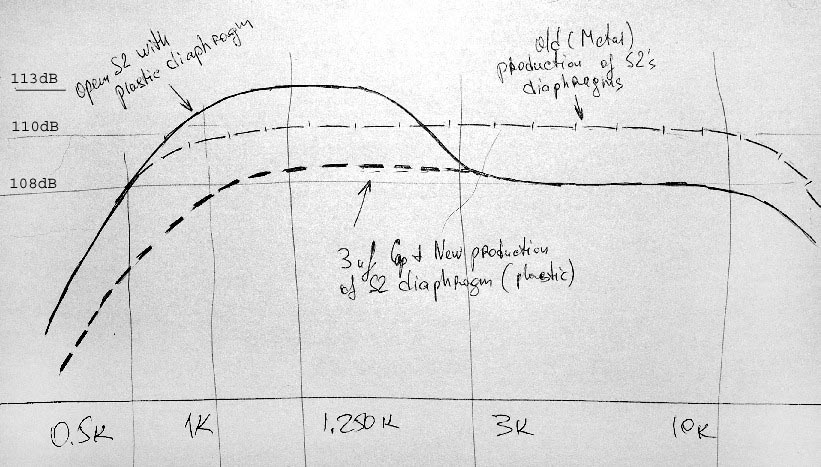Rerurn to Romy the Cat's Site
In the Forum: Horn-Loaded Speakers
In the Thread: Vitavox’s S2 Survival Guide.
Post Subject: "Different" way to use Vitavox S2Posted by Romy the Cat on: 4/10/2005
I just posted yeastoday the post above and have got already a few emails asking about the “new” ways that I am planning to use S2. OK, let me to explain what is going on.
The default Vitavox S2 driver comes with thier default aluminum diaphragm with metal surround/suspension. My previous experiments indicated that this diaphragm has some harshness and the very high frequencies (10-12kHz). I would describe is as some king of resonanses that although sound spectacularly attractive but they still alien to authentic sound. There are many ways to fight with those resonanses starting from a radical-barbarian approach that used by some guys in UK (they use S2 with very-very mild low-pass coil) to the way in which I do it (use a HF resonator to stretch/modulate those resonanses into useful HF) However, this is all about a degree of the affect. I learned that my “HF modulator approach” (more about it at “My Playback” at the Macondo section) works wonderful ONLY if the effect of S2’s HF harshness is very minor. If the harshness is too much then the “HF modulator approach” can’t eliminate it completely but juts minimize it.
Continue playing with S2 I discovered a few years back that the contemporary production of Vitavox S2 diaphragms (the aluminum cones with plastic surround/suspension) introduce way less HF harshness and for the years this was my chose how to use the S2 driver. With the contemporary S2 aluminum diaphragms the top frequencies are way smoother. However, those diaphragms have a huge secondly resonance at 1250Hz. To deal with it I used 3uF cap injecting 6dB per octave at 3.8kH that brought the S2 to 1kHz slop effectively flattening the secondly resonance bulge. (Refer to the image) Form one point of view this prevented to use the magnificent lower knee of the S2 driver but I have good-enough upper bass channel that took if form there. Also, the 3.8kH solution introduced a high electrical crossover point permitting the driver to have plenty spare exertion and to have a few “auxiliary” octaves under the crossover point.

Recently after writing the unpublished article “Upperbass preoccupation and Vitavox S2 driver” where I admired the S2 lower slope I asked myself if could I do something to take more advantages of it. In past I tried everything (including use of two paid of S2 – before and after the bulge) but I never was able to do anything with the secondly resonance swelling. And opened 6dB filter worked fine in there but as I was closing the EQ with another slope (a typical Zobel filter) then the bulge went away and along with the bulge sound when to toilet. I learn long time ago that if a speaker uses any impedance normalization networks then those speakers should not be used. My countless experiments with the Zobeling the S2’s swelling did cure the swell but converted the Vitavox S2 into Altec/JBL…
Anyhow, a picked among my S2 drivers the one that with old production diaphragm (metal surround/suspension) gave me a flat response all the way down to the horn’s roll-off, aligned the diaphragms, placed a huge (size of Coca-Cola can) Jensen 15uF/200V cap in serial with the driver (~700Hz first order) and screwed the driver into the Macondo.
Now, the S2 covers the range from 700Hz (6dB) to 12KHz with quite interesting benefit at the bottom knee. However, what I found surprising that the upper knee harshness now is way less aggressive then I anticipated and then I remember. Last time I did it those experiment 3 years ago and I remember that the harshness was un-handleable. There was nothing changed since then besides introduction of Melquiades and getting rid of the Lamm preamp from my system. I do not think that Melquiades might be a factor (?!) in it. However, the L2’s brutality at high frequency (with it rusty, "afterburned" sound) is something that very well documented and proved by me and I am sure that it was it. The L2 preamp had wrongly designed PS that made very difficult to get any civilized sound out of is if the tubes were more then 2-3 weeks old; also that preamp was hugely susceptive to the imperfections of power lines.
Still I feel that there is something in S2’s upper range that is not “kosher” and I will be working on it for next few days. The Jensen cap should burn in, a proper way of using the HF resonator/tweeter should be found, the ways to deal with S2’s 10Khz small pick should be discovered. I would need a few days to fugue the things out and will be reporting the results. However, the major revision that I would like to make is that the original diaphragms that Vitavox used in thier S2 are not as unusable as I initially thought. The Lamm L2 screwed me up in very many different things and this was one of them.
I will repot back where and how the S2 will end up in my Macondo.
Rgs,
Romy the Cat
Rerurn to Romy the Cat's Site